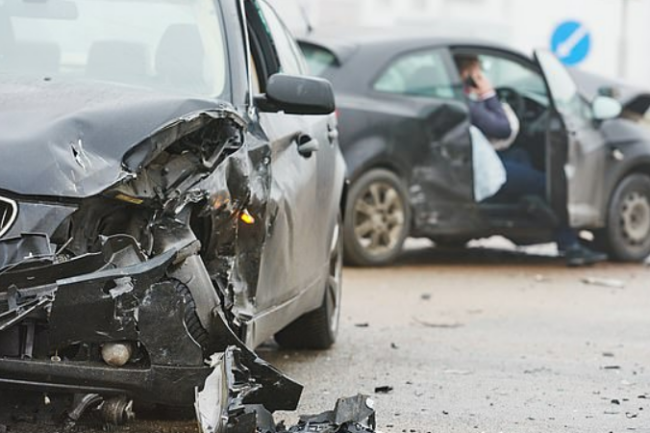Deadly car crashes spike in states including Minnesota, Louisiana and Missouri as drivers speeding over 100mph take advantage of deserted roads during coronavirus lockdown

- Several states have significant spikes in deadly car crashes since stay-at-home orders went into effect last month
- Meanwhile, the volume of vehicles on US roads has fallen by up to 63 percent
- Officials say the spikes are largely caused by people speeding on empty roads
- State highway patrols say they handing out record numbers of speeding tickets
- Here’s how to help people impacted by Covid-19
Several states have seen an unexpected increase in deadly car crashes despite far fewer cars being on the roads due to coronavirus lockdowns.
Minnesota and Louisiana recorded more traffic fatalities during the pandemic than in the same periods of past years, according to new data.
In states including Missouri, fatality rates have increased even as the total number of crash deaths declined.
Highway officials say the spike in deadly car crashes is largely caused by people having more room to speed on roads that have emptied out due to stay-at-home orders.
Between March 16 and April 21, 35 people died in car crashes in Minnesota – the highest number in that period in six years.
The same period also saw about half as many cars as normal along state roads, officials said.
‘There’s a lot more available lane space for people to use—and abuse,’ Michael Hanson, director of Minnesota’s Office of Traffic Safety, told the Wall Street Journal, adding that speeding and aggressive or careless driving were the most common factors in the lethal crashes.
In one instance, a Minnesota man pulled over for going 110mph told police he was just out for a joy ride.
State officials have since heightened calls for people to be careful on the road even when it’s empty.
Louisiana officials were surprised to see an increase in fatal crashes after a statewide stay-at-home order was issued in March, causing traffic to fall by about one-third.
Initial figures showed that 66 fatal crashes occurred between March 16 and April 20 – compared with just 62 during the same period last year.
‘That is a very concerning disconnect,’ said Lisa Freeman, executive director of the Louisiana Highway Safety Commission, stating that fatalities should have fallen.
Louisiana State Police officials cited lack of safety belt usage, impairment and distraction as major crash factors.
In Missouri, Department of Transportation Director Patrick McKenna said that while vehicle fatalities are down 10 percent, he isn’t impressed given that overall traffic volume is down 40 percent.
‘On a miles-driven basis, the fatalities are up,’ McKenna told WSJ, noting that his counterparts in other states have reported similar trends.
Traffic volume fell in every single state during the period from April 13-17 compared with the last week of February, according to transportation analytics firm Inrix.
The change in volume was particularly stark in the nation’s 10 largest metro areas: New York City (-63%); Miami (-59%); Philadelphia (-57%); Washington, DC (-56%), Los Angeles (-51%); Chicago (-50%); Dallas (-48%); Atlanta (-47%); Houston (-46%); and Phoenix (-43%).
Meanwhile, cars have been traveling much faster during rush hour periods, according to Inrix data comparing April 12-37 with the first two weeks in March.
That could be because with fewer cars on the road there’s fewer opportunities for gridlock, in addition to people speeding.
The largest increase in average rush hour speeds was observed in Los Angeles, where 5pm traffic was found to be moving 59 percent faster.
In California, the number of speeding tickets issued skyrocketed in the month after a statewide stay-at-home order went into effect on March 19, while traffic volume fell 35 percent.
The California Highway Patrol (CHP) said it wrote about 2,500 tickets to drivers clocked at more than 100mph from March 19 to April 19 – an 87 percent jump from a year earlier.
Meanwhile, the number fatal crashes reported during that period was well below average, with 10 compared to an average of 150 in same period over the previous four years.
A CHP spokeswoman credited the drop in fatal crashes to enhanced publication and enforcement.
The New York City area has also seen a dramatic spike in speeding since lockdowns went into effect.
Over a five week period beginning in mid-March, cameras captured 296,000 speeders – an 81 percent increase from the same period in 2019, per data from the city’s speed-camera vendor Verra Mobility.
Despite the speeding trend, city officials say traffic deaths have fallen sharply in recent weeks.
As a growing number of states move to roll back their stay-at-home orders, some experts are worried about how people will act on the roads.
‘My biggest concern is once we open up the floodgates and people can get out there and travel freely again, what are we going to see?’ said Pam Fischer, senior director of external engagement at the nonprofit Governors Highway Safety Association, which represents state highway safety offices.

